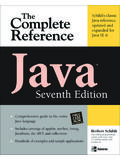Transcription of GCE Further Mathematics (6360) - filestore.aqa.org.uk
1 GCE Further Mathematics (6360) Further Pure Unit 2 (MFP2) Textbook Version: MFP2 Textbook A-level Further Mathematics 6360 2 Further Pure 2: Contents Chapter 1: Complex numbers 4 Introduction 5 The general complex number 5 The modulus and argument of a complex number 6 The polar form of a complex number 8 Addition, subtraction and multiplication of complex numbers of the form x + iy 9 The conjugate of a complex number and the division of complex numbers of the form x +iy 10 Products and quotients of complex numbers in their polar form 11 Equating real and imaginary parts 13 Further consideration of |z2 z1| and arg(z2 z1)
2 14 Loci on Argand diagrams 15 Chapter 2: Roots of polynomial equations 21 Introduction 22 Quadratic equations 22 Cubic equations 24 Relationship between the roots of a cubic equation and its coefficients 27 Cubic equations with related roots 28
3 An important result 31 Polynomial equations of degree n 32 Complex roots of polynomial equations with real coefficients 33 Chapter 3: Summation of finite series 38 Introduction 39 Summation of series by the method of differences 40 Summation of series by the method of induction 45 Proof by induction extended to other areas of Mathematics 48 Chapter 4.
4 De Moivre s theorem and its applications 53 De Moivre s theorem 54 Using de Moivre s theorem to evaluate powers of complex numbers 56 Application of de Moivre s theorem in establishing trigonometric identities 60 Exponential form of a complex number 69 The cube roots of unity 71 The nth roots of unity 74 The roots of nz , where is a non-real number 77 continued overleaf MFP2 Textbook A-level Further Mathematics 6360 3 Further Pure 2: Contents (continued) Chapter 5.
5 Inverse trigonometrical functions 85 Introduction and revision 86 The derivatives of standard inverse trigonometrical functions 89 Application to more complex differentiation 91 Standard integrals integrating to inverse trigonometrical functions 94 Applications to more complex integrals 96 Chapter 6: Hyperbolic functions 102 Definitions of hyperbolic functions 103 Numerical values of hyperbolic functions 104 Graphs of hyperbolic functions 105 Hyperbolic identities
6 106 Osborne s rule 110 Differentiation of hyperbolic functions 111 Integration of hyperbolic functions 114 Inverse hyperbolic functions 115 Logarithmic form of inverse hyperbolic functions 116 Derivatives of inverse hyperbolic functions 119 Integrals which integrate to inverse hyperbolic functions 122 Solving equations 125 Chapter 7.
7 Arc length and area of surface of revolution 131 Introduction 132 Arc length 133 Area of surface of revolution 137 Answers to the exercises in Further Pure 2 143 MFP2 Textbook A-level Further Mathematics 6360 4 Chapter 1: Complex Numbers Introduction The general complex number The modulus and argument of a complex number The polar form of a complex number Addition, subtraction and multiplication of complex numbers of the form ixy The conjugate of a complex number and the division of complex numbers of the formixy Products and quotients of complex numbers in their polar form Equating real and imaginary parts Further consideration of 21zz and 21arg()zz Loci on Argand diagrams This chapter introduces the idea of a complex number.
8 When you have completed it, you will: know what is meant by a complex number; know what is meant by the modulus and argument of a complex number; know how to add, subtract, multiply and divide complex numbers; know how to solve equations using real and imaginary parts; understand what an Argand diagram is; know how to sketch loci on Argand diagrams. MFP2 Textbook A-level Further Mathematics 6360 5 Introduction You will have discovered by now that some problems cannot be solved in terms of real numbers. For example, if you use a calculator to evaluate 64 you get an error message. This is because squaring every real number gives a positive value; both 22(8) and (8) are equal to 64.
9 As 1 cannot be evaluated, a symbol is used to denote it the symbol used is i. It follows that 64641641 8i. The general complex number The most general number that can be written down has the form i ,xy where x and y are real numbers. The term ixy is a complex number with x being the real part and y the imaginary part. So, both 23i and 14i are complex numbers. The set of real numbers, (with which you are familiar), is really a subset of the set of complex numbers, . This is because real numbers are actually numbers of the form 21ii1 MFP2 Textbook A-level Further Mathematics 6360 6 The modulus and argument of a complex number Just as real numbers can be represented by points on a number line, complex numbers can be represented by points in a plane.
10 The point P(x, y) in the plane of coordinates with axes Ox and Oy represents the complex number ixy and the number is uniquely represented by that point. The diagram of points in Cartesian coordinates representing complex numbers is called an Argand diagram. If the complex number ixy is denoted by z, and hence i,zxy z ( mod zed ) is defined as the distance from the origin O to the point P representing z. Thus .zOPr The argument of z, arg z, is defined as the angle between the line OP and the positive x-axis usually in the range ( , ). You must be careful when x or y, or both, are negative. x y O r P(x, y) The modulus of a complex number z is given by 22zxy The argument of a complex number z is given by arg,z where tanyx MFP2 Textbook A-level Further Mathematics 6360 7 Example Find the modulus and argument of the complex number 13i.













